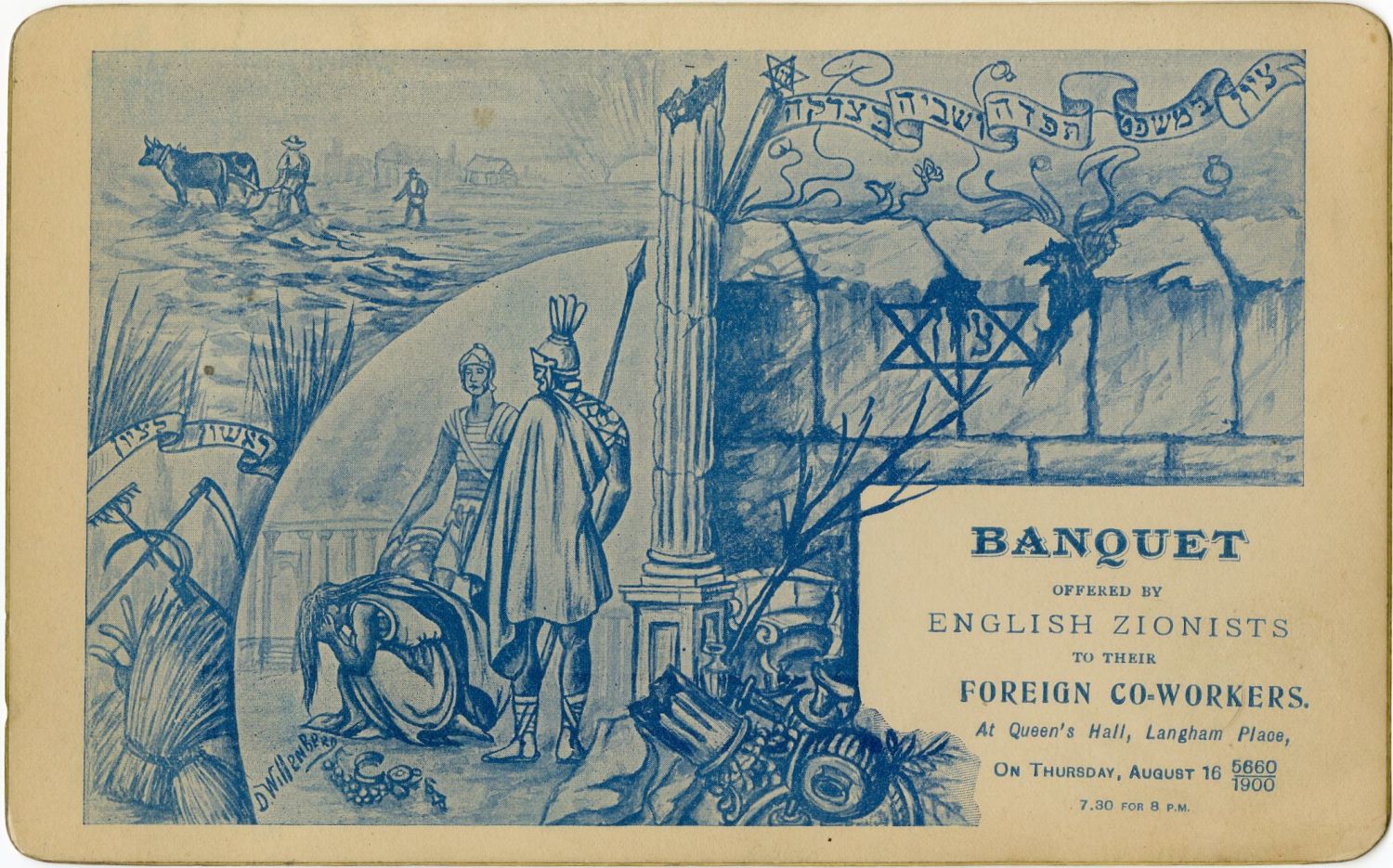
Banquet offered by english zionists to their foreign co = workers - Designed invitation board for the last day of the Fourth Zionist Congress on August 16, 1900 - To discuss the development of the Hebrew colonies and their future.
At this congress, among other things discussed, The situation of 532 families working in the Hebrew colonies , which was a small and productive minority among the Jewish community of about 50,000 people. The existence of the workers and their families was in danger because of the transfer of the colonies from the custodianship of the generous to J.C.A that year . The Congress's location in the United Kingdom was chosen to influence the British government and public opinion in the United Kingdom, to allocate territories in areas under its control and close to the Land of Israel. For this purpose, the last congressional hearing day was dedicated on August 16, 1900. Before us Designed invitation board by D. Willenberd calling to attend an event held at the Queen's Hall where these issues will be discussed.
In the center a girl kneeling at her feet, representing the Jewish communities alongside English knights coming to aid, to the left a peasant grove and the name of the "Rishon LeZion" colony [which numbered only 400 people in those days and its future was foggy]. to the right the verse: "'ציון במשפט תפדה ושביה בצדקה' " And Magen David with the caption: 'Zion'. The illustrator presents the future of the Hebrew colonies with the assistance of the British Kingdom.
Rare. Do not appear 'Cachol Lavan bizvahim Visual images of Zionism' Beit Hatfuzot, 1996.
Hard board 20x13 cm. Gilded frame. Very good condition.

A postcard issued on the occasion of the 5th Congress in Basel in 1901 with an illustration in the "Jugendstil" style by Ephraim Moshe Lillan.
A beautiful angel with a Star of David on his chest, Shielded with wings on a tired adult, handcuffed in exile, and leaning on the wand. The angel points toward a grove representing Zion and faces the rising sun [a common motif in the Zionist images of salvation], and a verse from the prayer: "And our eyes will see you return to Zion with mercy." [Signed in lower right: Lilien].
Rimmer No. 6. Undivided Back Postcard. Sent from Basel in 1901.
Good condition except for a tiny filing hole, a slight wrinkle, and some stains.

Invitation to a sporting artistic prom of the Trumpeldor Alliance in Eretz Israel - Ken Tel Aviv, young Betar rank. October 1941.
"We are honored to invite you to the Betar Sports party of the Young Betar, which will be held Saturday Night of Sukkot on the night of October 11, 41, at 8.30 pm in the "Isa - Heifetz" hall. In the program: Opening - choir play, harmonica orchestra, singing - sports performances, various etc. Welcome to Tel Hai! "
13x10 cm. review part on the right not cut. Few stains. Very good condition.
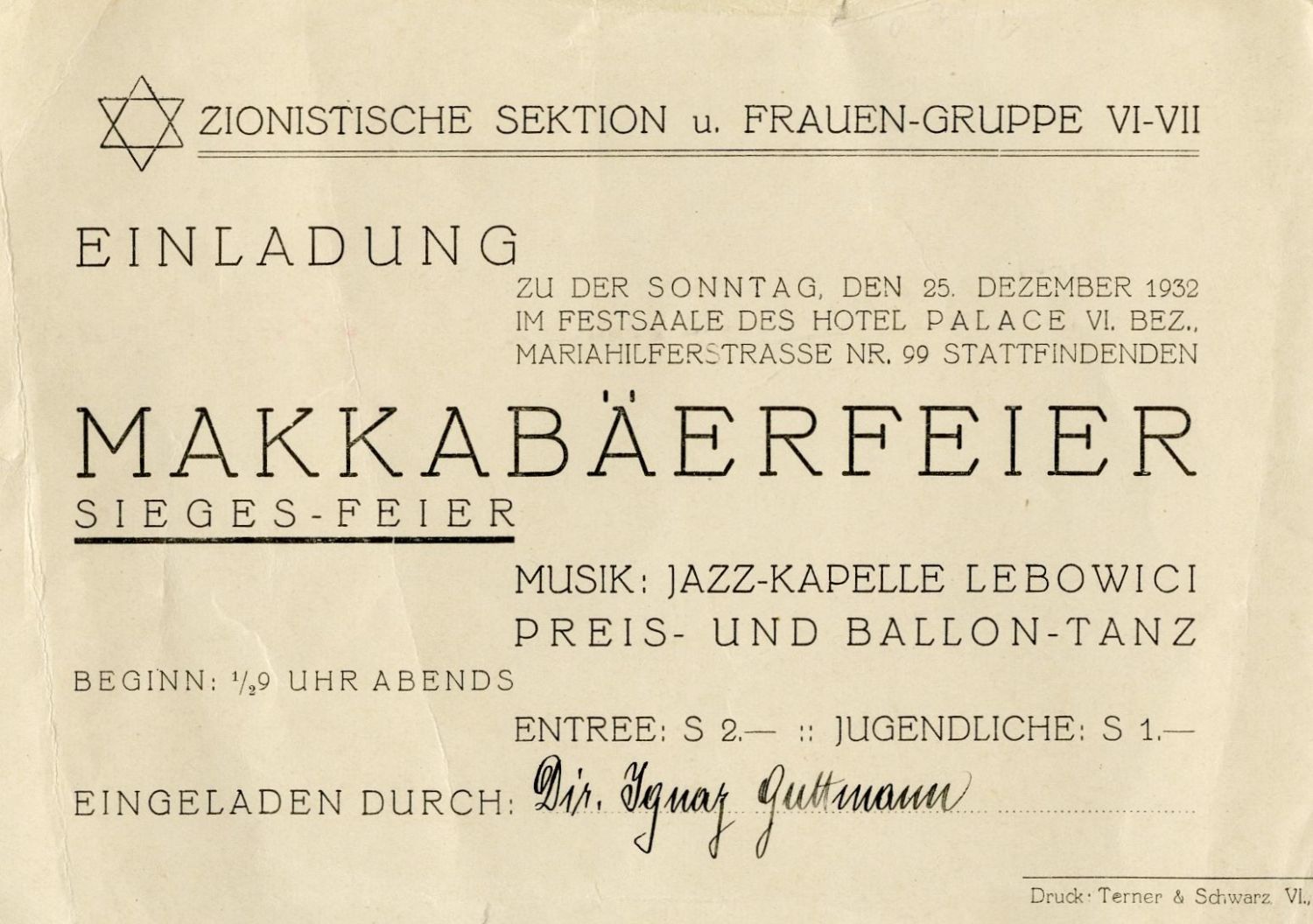
Five paper items of the 'Maccabi' sports organization. The 1920s and 1930s.
* Invitation by the Zionist Division to the Maccabi Women's Conference held on December 25, 1932. In the program: LEBOWICI jazz player and other artists. Sent to Ms. Gutman. On the back of the reservation the plan of night. [Card opens, 4 pages, 15X11 cm].
* Member card of Elazar Zweig active in the Maccabi Athletics Department, Jerusalem 1929. Signature of the Secretary G. Spiegel and the Chairman v. Rosenthal. On the back Maccabi Principles and Association Regulations.
* The annual convention for sports of the Hebrew schools in Jerusalem on the Maccabi field, 1932.
* Handwritten letter regarding the printing of the Maccabi monthly for the physical inauguration, June 15, 1931.
* The 'Maccabi Booklet' - For Exercise and Sport in Eretz Israel, Tevet 1924. Published at the Sign of Coming of the 'Hakoach' Group to Eretz Israel. "We must pump in the Land of Israel from the presence of 'Hakoach'- the first Jewish sports group, Adopt And encouragement in our actions ... ' .
Various sizes, very good condition.

Two admission tickets to the UN Special Committee on Israel held in YMCA concert hall in 1947. 'Valid for one half day only'.
On the back of the ticket are instructions in three languages: Hebrew, English, and Arabic: 'Ticket holders are requested to be in their seats at least 20 minutes before the time of the opening of the public Hearing. the time will be announced in the press'.
UNSCOP - The United Nations Special Committee on Palestine - was an international commission of inquiry appointed by the United Nations General Assembly in May 1947 to examine the question of Israel. After all the previous plans were rejected and as the struggle of the settlement continued, the United Kingdom decided to bring the issue of Palestine to the United Nations rally. The UN appointed an 11-member committee from various countries, which came to Israel, and met with Jewish and Arab behavior, as well as collected numerous testimonies about what was happening in the country from various sources. On August 31, 1947, the Commission submitted its plan to the UN, which would end the British mandate and the country would be divided into two states, Jewish and Arab, which would cooperate economically and Jerusalem would become an international region. On November 29, 1947, the United Nations accepting the partition plan and ending the British Mandate on Israel on May 15, 1948. This laid the foundation for the establishment of the State of Israel.
Same size: 12.5x8.5 cm. On one of the cards is Ms. Samson's name. Very good condition.
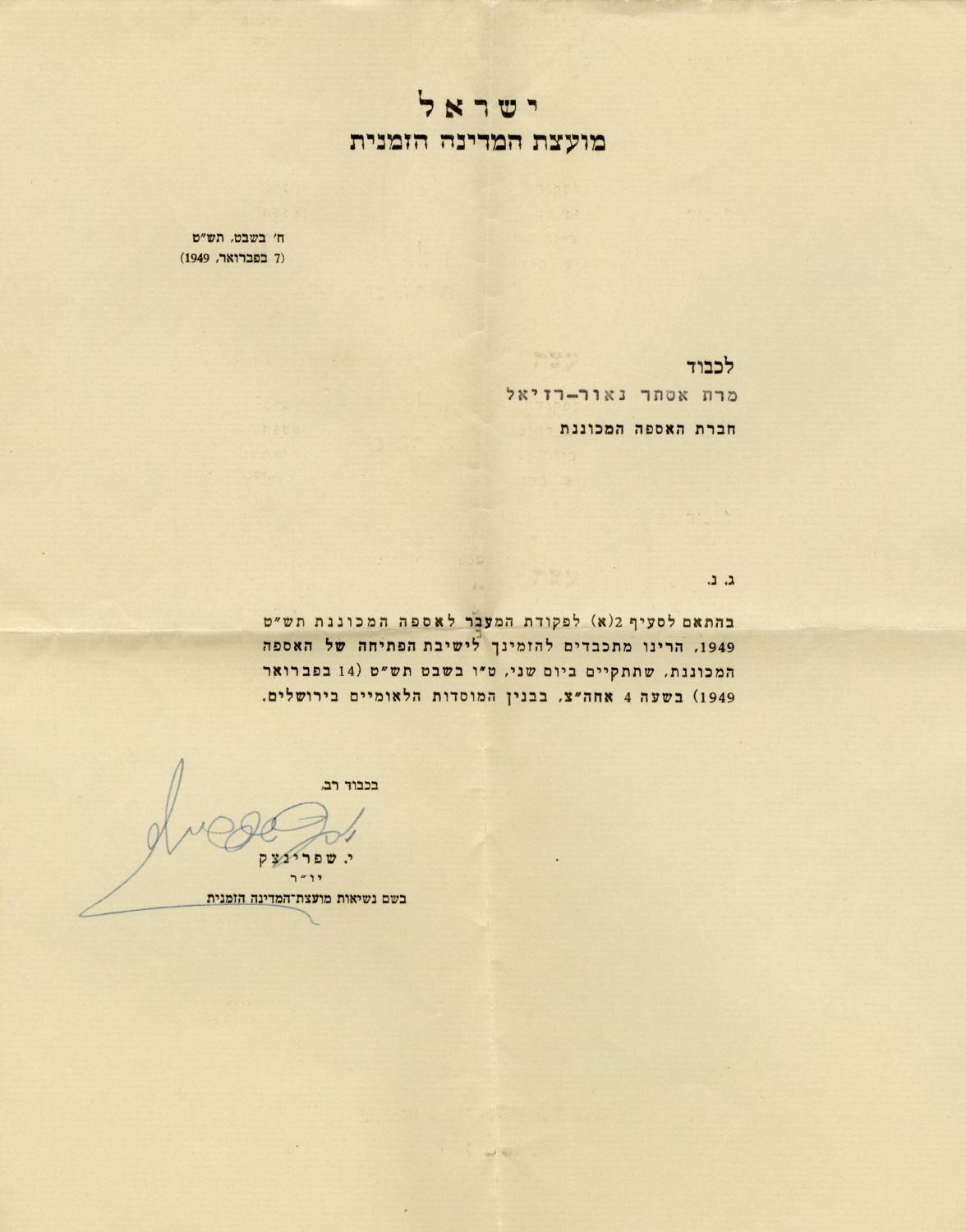
An official invitation by the Provisional State Council to a constituent assembly signed by the first Chairman of the Knesset Yosef Shprintsak. Sent to Member of the Constituent Assembly Esther Raziel February 7, 1949.
"In accordance with section 2 (a) of the Transition to the Constituent Assembly, 1949, we are honored to invite you to the opening meeting of the Constituent Assembly, which will be held on Monday, 15 B'Shvat (February 14, 1949) at 4 p.m., at the National Institutions Building In Jerusalem. Yours sincerely, Yosef Spryneck, Chairman, on behalf of the Provisional State Council President."
The Constituent Assembly was the first elected body in the State of Israel, whose function was to establish the constitution of the State of Israel. The assembly was set for election to the Constituent Assembly on January 25, 1949. The Declaration of Independence stipulated that the Constituent Assembly would establish a constitution for the state by October 1, 1948, under which the "elected and regular authorities of the state" would be established. In fact, the Assembly first convened in Shvat 15 1949 (February 14, 1949), and within only two days decided to change its designation from a constituent assembly to a legislature called "the Knesset."
[1] Official Paper 'Provisional State Council' . 27x21 cm. Folding marks, very good condition.
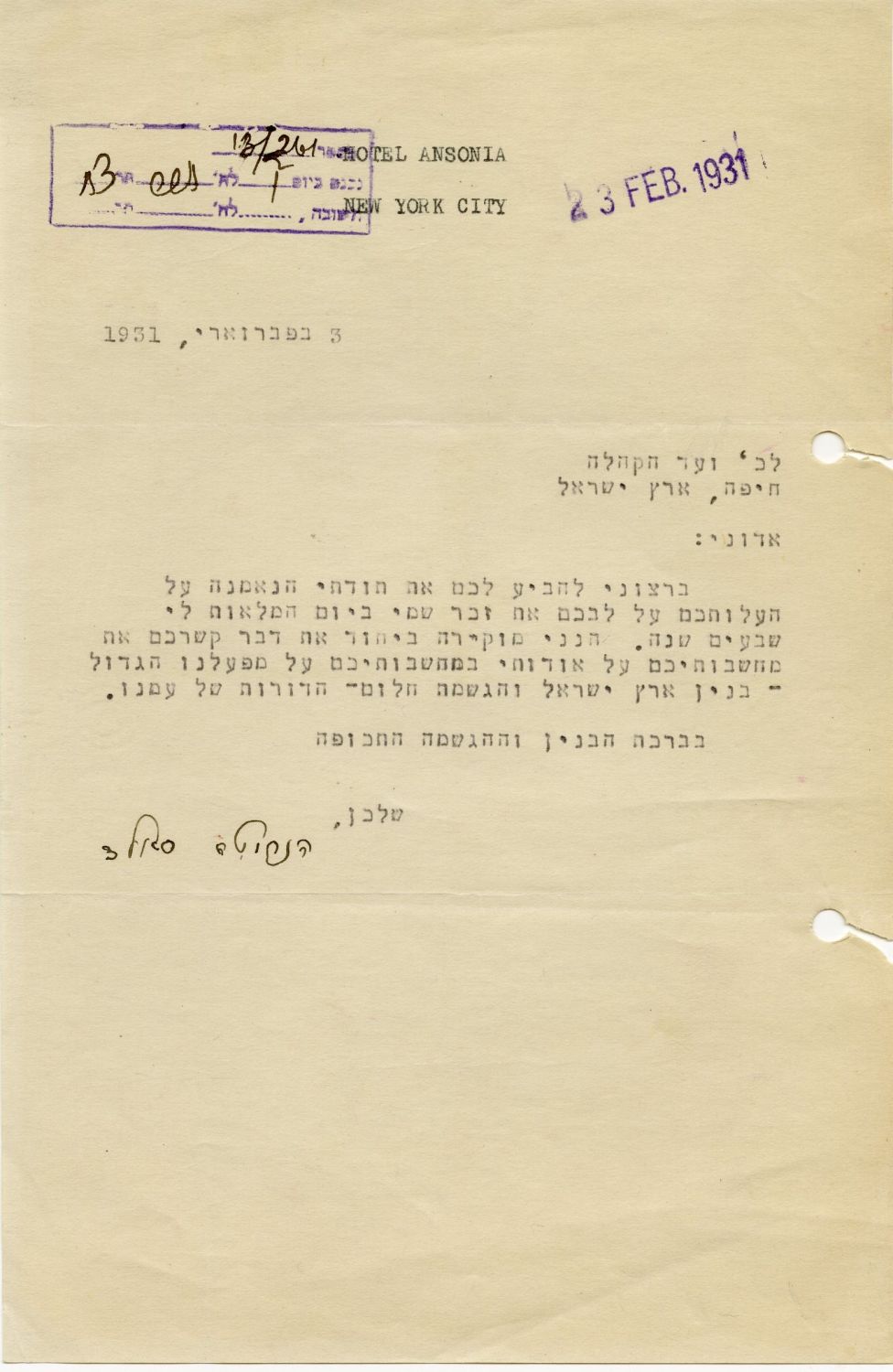
A letter signed by Henrietta Szold, was sent to the Haifa community committee from her New York seat. February 3, 1931.
'I would like to express my sincere thanks to you for have made up on your heart the memory of my name on my seventieth birthday. In particular, I cherish your connection to your thoughts about me in your thoughts on our great enterprise - building the Land of Israel and fulfilling our people's dream of generations. With the blessing of the building and the frequent fulfillment. Yours, Henrietta Szold.
In 1930, Szold celebrated her 70th birthday with her long-time friends and acquaintances in the United States, where she was following Haim Weizman's mission to fill the advocacy positions to strengthen the Zionist movement in America. In the same year, under the initiative of Dr. Stephen Samuel Wise, the institution was awarded the Honorary Doctor and thus became the first woman to receive this degree from the institution. Szold, who in those days was renamed all over the Jewish world received letters of blessing on the occasion of her birthday, also from various parties who were in Israel at that time. A year later she was called back to return Israel.
[1] leaf of the ANSONIA Hotel in New York City. stencil Print with Szold's signature. Filing holes. Very good condition.

Letter in the handwriting and signature of Prof. David Yellin - the Hebrew language scholar. Addressed to Israel Michal Nathanson. A postcard, kislev 15 1940, a few months before Yellin's passing.
In his letter, Yellin disagrees with Nathanzon's meaning of the word 'bell' in Arabic, which he thinks is 'opinion', adding that 'there is no need for all the urgent interpretations you have brought' and conclude
forgive me because I contradict your words because I love the truth more than anything"
. below Yellin's signature.
Prof. David Yelin [1864-1941] Teacher, Hebrew scholar and public figure, Mayor of the Yishuv, Mayor of Freemasonry in Israel, Founder of David Yellin College, founder of the Teachers Union and Hebrew Language Committee, chairman of the National Committee, and the founders of the Zichron Moshe neighborhood in Jerusalem. Yellin was a major personality in reviving the Hebrew language, and was very active in renewing words. Unlike Ben-Yehuda, who often turned to the Arabic language to enrich the Hebrew language, Yellin was an independent innovator, who relies on ancient Hebrew sources. He would often seek a word from the sources and renew its meaning, even if its new meaning did not match the original one.
[1] David Yellin's official postcard. Moisture stains. Miss the top right corner. Moderate condition.
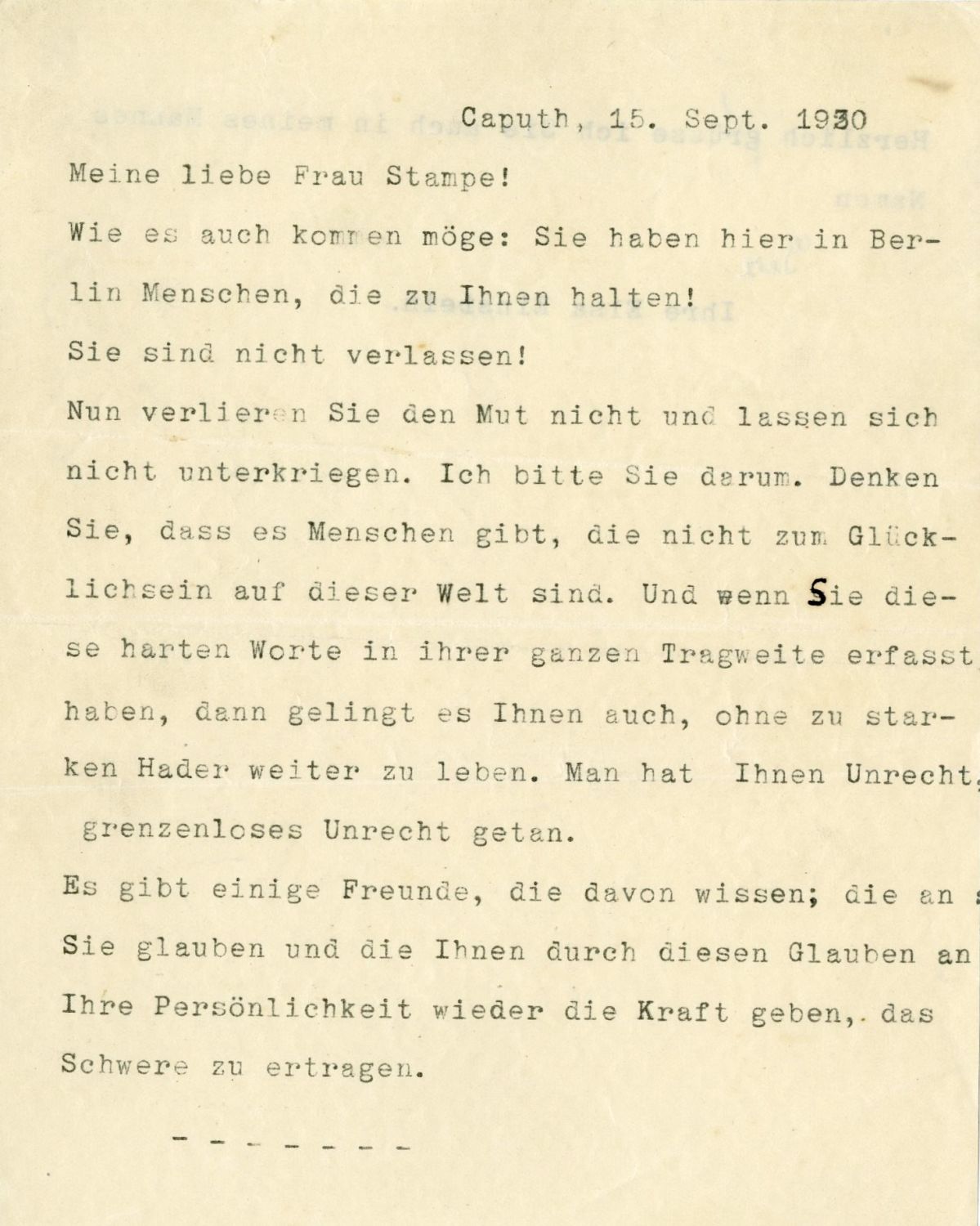
A letter sent from Ms. Einstein to family friend Mrs. Karin Stampe after a great injustice was done to her. In her letter, Ms. Einstein reinforces her with warm and supportive words about "the facts of life." September 15, 1930. Letter printed in German Signed by Elsa Einstein.
Contents of the letter (translated from German)
"My dear Mrs. Stampe!
Whatever happens, you have people here in berlin who stick with you! you are not abandoned! now do not lose your courage and do not let it get you down. Therefore i ask you, think that there are people who are not happy in this world. and if you have grasped these harsh words in their full scope, then you also manage to continue to live without too much strife. you have been wronged, boundless injustice done.
i greet you in my name, Elsa Einstein"
[1] leaf (two pages). Very good condition.

A handwritten and signed letter by renowned etching artist Herman Struck in which he appeals to the rabbis: 'I have received your warm greetings, which I think is a great honor.' Haifa, 1926.
Struck, born in Berlin in 1876, all his days cherishing the rabbis and even being active in the Mizrachi movement. This letter was written from his home in Haifa about 4 years after his immigration to Israel with his wife.
[1] leaf. Filing holes. Very good condition.

FORM OF SERVICE TO BE HELD IN THE COLLEGIATE CHURCH OF ST. GEORGE THE MARTYR, JERUSALEM ON DECEMBER THE NINTH - The Day of the occupation of Jerusalem. " To thank and glorify g-d ... and send his blessing on the holy land in the future" Rare prayer order composed for the three religions in Hebrew, English and Arabic on the occasion of the British conquest of Jerusalem on December 9, 1917.
The occupation of Jerusalem by the British was one of the climaxes in the campaign on Sinai and Israel during the First World War. Jerusalem surrendered to the British Army without a fight on December 9, 1917, after the Ottoman army withdrew from the city the night before. General Edmund Allenby entered the city two days later, on December 11, officially accepting the surrender. This ended the Ottoman regime's 400 years of rule over Jerusalem and Israel, and the British rule over Israel began. The event expressed to the British the desire to renew Christian control in Jerusalem, which ended with the defeat of the Crusaders and their departure from the Land of Israel centuries earlier. The British conqueror considered his occupation a formative step for the three religions . Therefor, when General Allenby entered the gates of Jerusalem with his officers He got off his horse and walked by his foot through the Jaffa Gate out of respect for the Holy City of Judaism, Christianity and Islam. In his official declaration, Allenby even expressed this attitude: " Do not fear any of you in light of the experience you had of the departing opponent ... Because the followers of the three great religions of mankind have affection for your city, and its land is sacred in the prayers and pilgrimages of devout people of these three religions for many centuries Therefore, I have informed you that any sacred structure, a memorial, a holy place, a temple, a traditional site, a sanctuary, a religious heritage site, or a traditional place of worship of all forms of all three religions will be preserved and protected according to the existing customs and beliefs of those It is sacred."
After the conquest of the south, Loyd George ordered General Allenby to conquer Jerusalem " as a Christmas present to the Christian world" (which took place two weeks later), the bells of all the churches in Rome rang for a full hour, and in other places, and on the other hand, Jerusalem Jews lit a first candle Of Chanukah that evening and congratulated her on the resurgence that appeared " Bayamim Hahem bazman hazeh."
Against this backdrop, the prayers before us compiled in the three languages. Alongside confession, the sanctification of G-d, and the tenets of the faith, are words that refer to the great event: The Lord's Prayer will remember the souls of the heroes who sacrificed their souls for the great thing in the Holy Land and everywhere: " Everyone who gave their lives to liberate the Holy Land" Peace on earth, great and great peace that the world did not know from ever" . And a solemn prayer to thank the G-ds for victory and salvation: " We glorify you and thank you for the victory we have instilled in this great and terrible war of recent times ..." .
Rare prayer. one copy in the National Library, and only one copy in the Center for Jewish History, NY. Not seen in recent years. See also Christies auction - London, April 21, 2016.
20 p. 21 cm. Original cardboard binding. Very good condition.
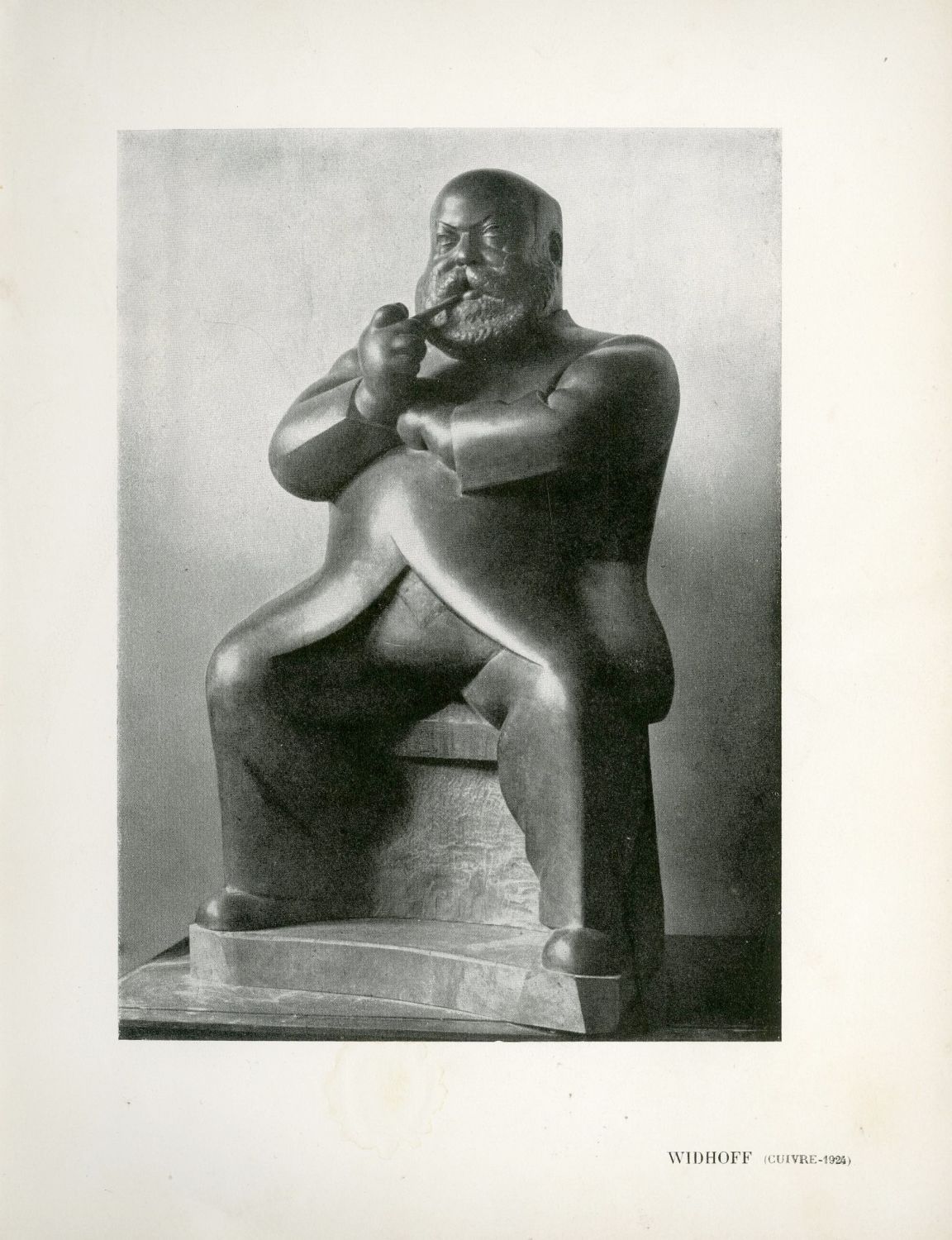
Collection of Early Publications: First Zionist Congress, Palestine, and British Mandate.
* Protocol of the first Zionist Congress in Basel in 1897, Prague 1911.
* A BRIEF RECORD OF THE ADVANCE OF THE EGYPTIAN EXPEDITIONARY FORCE - under General Allenby's control, July 1917-October 1918, London, 1919. Dozens of maps of the Land of Israel. The report describes the course of the British war with the Ottomans over Israel between July 1917 and October 1918 under the command of General Allenby. Among other things, the report shows the course and progress of the fighting, the various positions held, the details of the troops, the order of the forces and the quantities of ammunition and weapons. At the end of the report fifty-five colored maps showing the progress of British forces and the withdrawal of Ottoman forces from the south to the north: From Gaza and Beersheba through Judea, Samaria and the Galilee, to the conquest of Damascus and northern Syria.
* Sion et liberte, 1919 Tunisia.
* Sheets of regulations and orders of the Palestinian government regarding the printing and publication of newspapers and other printed matter, book registration and printing houses - 1933 and 1942.
* Lecture by the Royal Commission on Palestine, submitted to Parliament by the Secretary of State for Colonial Affairs by order of His Majesty in July 1937. Official translation. Includes two maps of the Land of Israel.
* Addendum No. 2 to the Official Journal Issue 737 - November 1937, Issue 766 March 1938.
* GOVERNMENT OF PALESTINE HORTICULTURAL ATATISTICS FOR THE YEAR 1937/38
* Official Gazette of the Palestinian Government - Special Issue of February 15, 1943.
Various sizes and conditions.

Personal Identity card of a Jewish soldier who served in the armies of Nicholas II Emperor of Russia during World War I.
The certificate bears the portrait of Nikolai - the last emperor of the Russian Empire, and the filling of the soldier's personal details with the detail of the year 1914.
In the Czar's army, about half a million Jews served, the highest number of Jews in World War I armies and many of them fought in the front against Jews in the German and Austro-Hungarian armies. Some even volunteered for combat positions to emphasize their loyalty. During the war the Russians had no suitable plans for partial mobilization, and on July 31, 1914, Nicholai made the fateful move and ordered general mobilization. This led almost immediately to a German war declaration, and Russia's entry into World War I. On the eve of the war on August 1, 1914, he found Russia unprepared for the impending confrontation. The war began with heavy Russian casualties and lost territory. Nikolai felt that it was his duty to lead his army personally, taking on the role of commander-in-chief of his uncle, Grand Duke Nikolai Nikolaevich Jr. (in September 1915) after the loss of the Russian part of Poland. On December 22, 1917, Soviet Russia signed a ceasefire with the Center Powers and actually left the war.
39 p. 18 cm. Stains. Good condition.
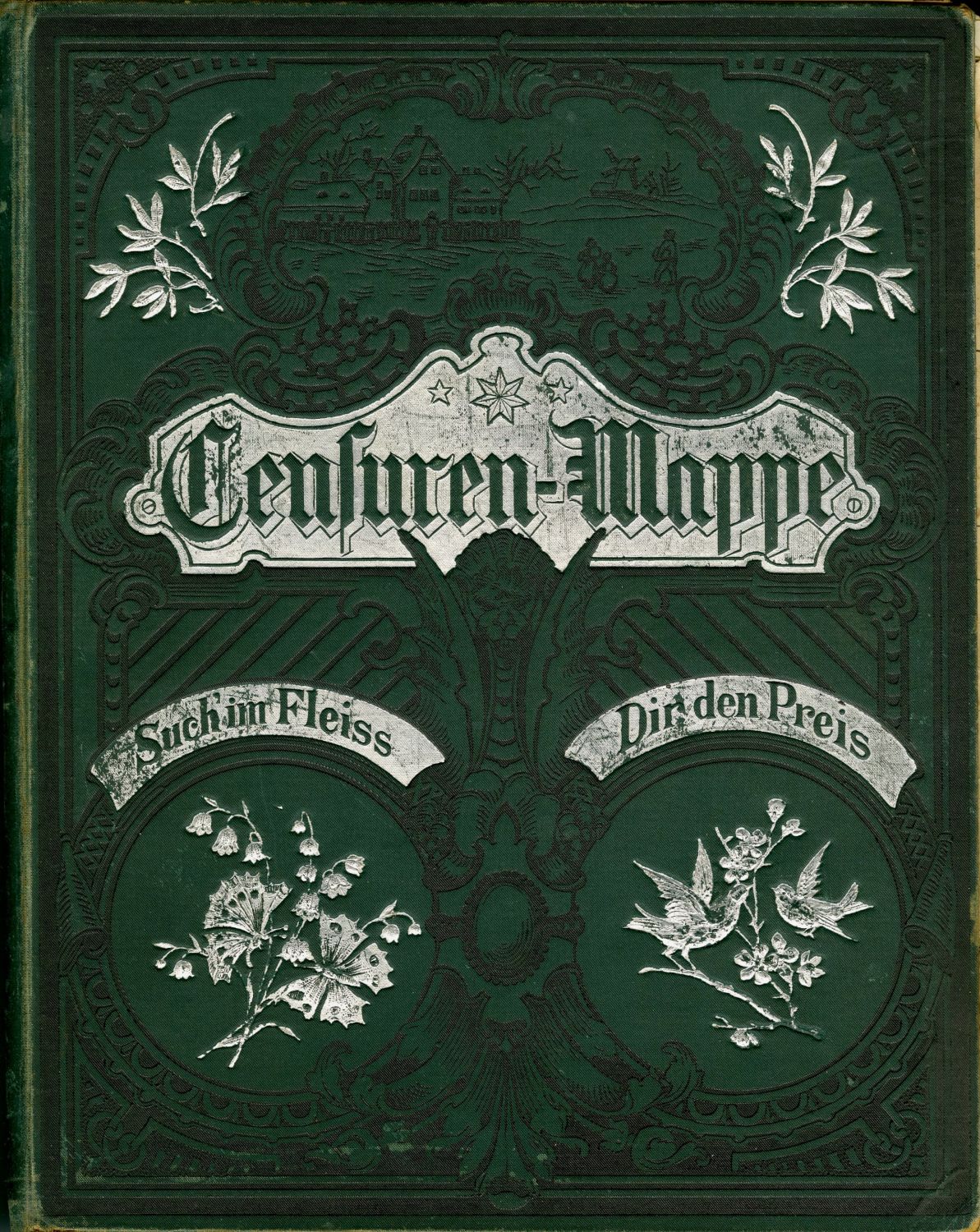
Large collection of 70 graduation certificates with grades of student in the Jewish school of the Adass Israel community in Berlin [Religionsschule der israelitischen synagogengemeinde Adass Jisroel zu Berlin]. Years: 1895-1932.
Various student certificates with grades in subjects taught at school. Alongside the Holy Studies: Pentateuch, the Bible, Jewish History, grades are found in the secular professions: geography, literature, nature, writing, sewing, poetry, German language, and gymnastics.
Each certificate includes the student's name, the year, the teacher's signatures, and the school principal signatures.
The certificates are in two cardboard boxes from the period.
The Adass Jisroel community is a neo-Orthodox Jewish community that existed in Berlin from 1869 to the present. The first rabbi of the community was Rabbi Dr. Azriel Hildesheimer. Due to the accelerated assimilation of the Jews of Berlin, the community completely withdrew from the Jewish community of Germany and, about 20 years after its establishment, was also officially recognized as a separate religious community, which maintains the Jewish tradition and general studies. During the two world wars, the community developed and another synagogue, First Jewish High School, Teachers College and Community Hospital was established, and it also employed butchers and bakers to provide fancy kosher food to the community's Jews.
Some of the certificates have minor tears at the margins. overall Very good condition.

He - Chalutz' album in Poland. 12 photos by Moshe Verovichik. Published by the Chalutz Federation in Poland, He- Chalutz Fund, Warsaw, 1935. Rare.
Twelve photographs depicting the pioneer's activities in the various Polish cities, some of them photomontage: in the Clousova quarry, a farm in Grochow, the field work in Grochow, a farm in Tschstichowa, in the Radom tanneries, a group of porters in Lutsk, sewing in Lodz, near the gravel in Clozow, And more. The last page shows pioneers in the field by Issachar Ber Ryback.
20x13 cm. Very good condition.

Issues 1-37, which came out as the weekend supplement to the popular Jewish newspaper 'Di Yiddish Shtime'. Kovno, a full set of 1924 issues. The first Zionist daily newspaper in independent Lithuania.
" Di Yiddishi Shtima" (" The Jewish Voice" ) was a daily Yiddish newspaper published in Kaunas between 1919-1940. Head of the Jewish press in the First Lithuanian Republic, and the first Zionist daily in Independent Lithuania. The first issues appeared in primitive print conditions, in two small pages and in capital letters. Payment for the paper was in German pennipigans - one of the remnants of Lithuania's German occupation during World War I. The paper would appear at noon with the date of the next day. In the 1920s, an expansion period was imminent. The paper increased in number of pages, and regular additions were included, including the
" Die Welt" (" The World" ) before us, which also contained pictures.
The paper was founded by the Zionist Organization in Lithuania but was in fact the recognized expression of Lithuanian Jewry in general. He served as a host for writers, poets, publicists, and young journalist from all streams and parties. In major articles, field lists and articles he recommended, the loyal advocate of the Jews of Lithuania, the warrior newspaper that headed their wars and wars for their basic national-autonomous rights and reflected daily throughout its existence, the problems and fears, joys and sorrows of the local Jewish community. The newspaper was the only source of news from the big world for Lithuanian Jewish masses. A definitive imprint on the patterns of the newspaper was Reuben Rubinstein, who joined the newspaper system in 1923 and became its editor-in-chief in 1925. The Jews of Lithuania, its businesses and its activists, over the years, have adopted the Rubinstein word in " Shtima" , spoken and written in his own language and flourished his sayings in their arguments and speeches. In addition, the newspaper provided an extensive platform for the publication of Zionist activity in the Land of Israel. Each week the supplement published a photograph of the Land of Israel under the title: " Pictures of the Land of Israel" . The end of the newspaper in 1940 with the Soviet occupation.
37 sheets bound " Die Welt" newspaper supplement, stains. Moderate-good condition. Some sheets with torn edges, fragile paper, and detached pages.
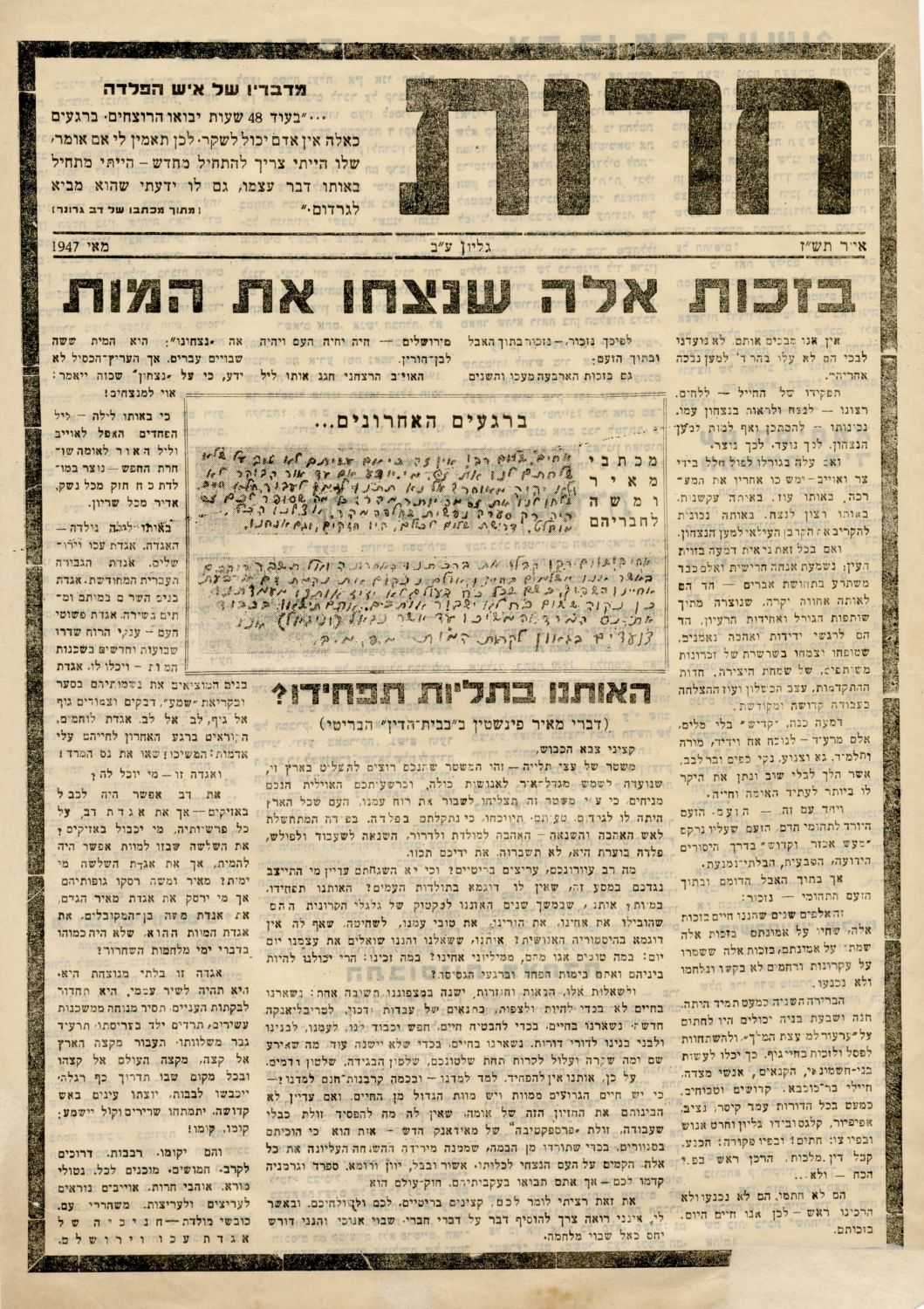
In 48 hours, the killers will come, in such moments no man can lie. So believe me if I say that if I had to start all over again - I would do the same thing , even if I knew it's Brings to the gallows'. An historical issue of the Herut Newspaper from May 1947 (issue 72), which reviews the recent moments of the "gallows immigrants" sentenced to death by hanging by the British - the first publication of the letters by Dov Gruner, Meir Feinstein, and Moshe Barzani before their death.
In the special memo published about a month after the twelve Israeli fighters were executed by the British, as a punishment for a series of offenses prohibiting the use of firearms, attempted murder, and assassination of British soldiers. the last letters of the Three were first brought to the public : 'We stayed alive to ensure life, freedom and respect for us, our people, our sons for generations ... We should not be scared. We have learned ... that there is a life worse than death and there is death bigger than life' '[Meir Finstein said in the British Court quoted on the cover of the issue]. Under the headline: 'In the last moments ...' appear the letters of Meir Feinstein and Moshe Barzani who wrote to their friends before their death 'We are proudly marching towards death'. The editor's article is saturated with admiration for Those executed: "They did not sign, they did not surrender and did not bow - so we live today thanks to them", as well as harsh criticism against British rule named 'The neo Nazi British rule' and 'regime of hanging'.
The Three:
Meir Feinstein [1927-1947]: Caught after placing bombs in suitcases at the Jerusalem train station that resulted in the killing of a British police officer who tried to dismantle. He committed suicide in the prison cell along with Moshe Barzani on April 21, 1947, about four hours before the date set for their execution.
Moshe Barzani [1926-1947]: Caught carrying a grenade, and charged with attempting to assassinate the military commander of Jerusalem.
Dov Gruner [1912-1947]: Arrested during the attack on Ramat Gan police. Executed on April 16, 1947.
[2] p. Restoration in the bottom right corner with no text damage. Good condition.
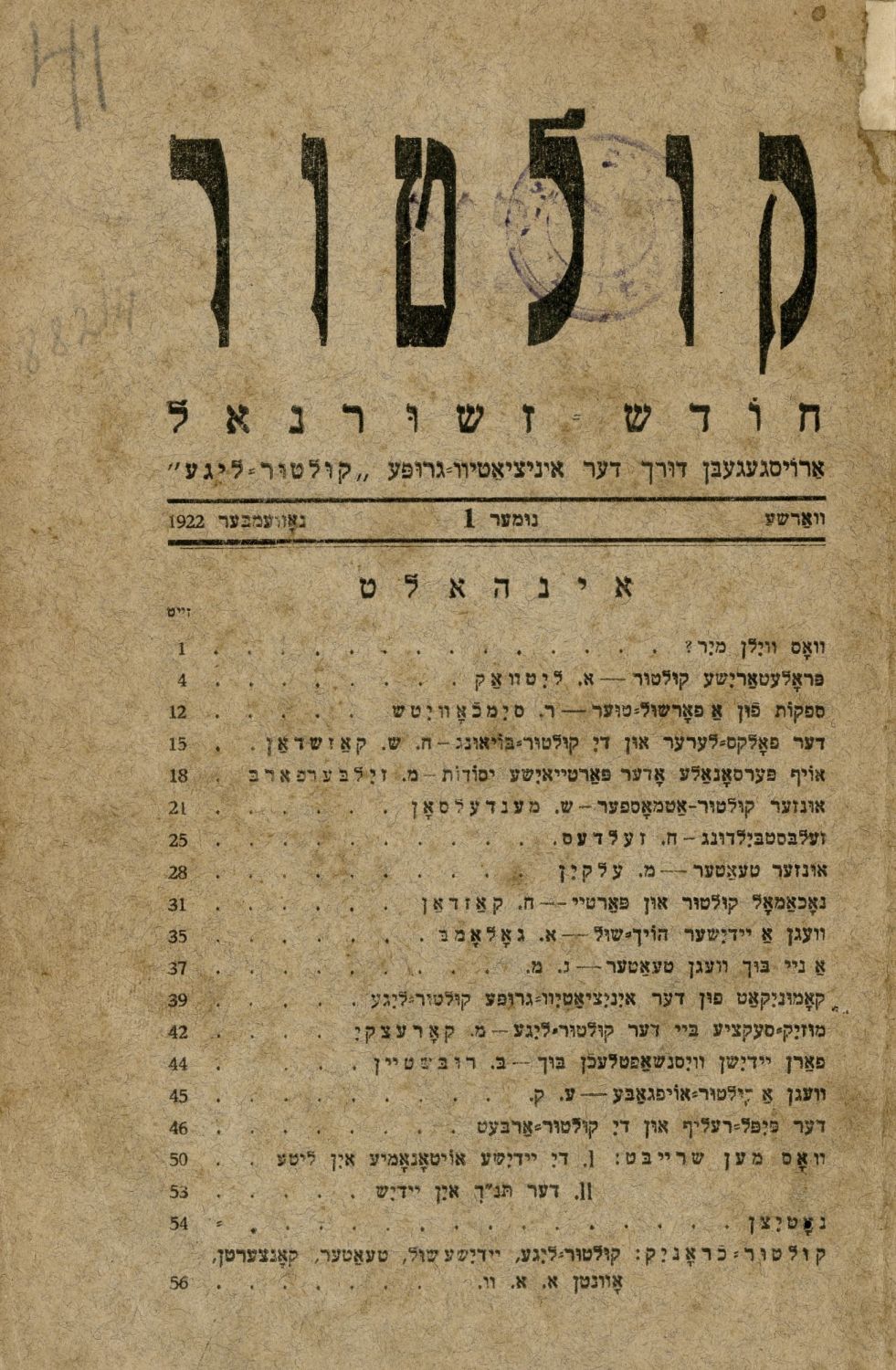
Culture' Month Journal published by the 'Culture League'. Warsaw, November 1922. First issue of Culture League in Warsaw.
The Culture League magazine, published in Warsaw after some members of its Central Committee had to move from Kiev to Warsaw due to pressure from the communist government. In the magazine and articles on the continuation of the "Culture League", and the attempts of its leaders to establish a general-Polish culture league. In the articles, the group's efforts are evident in defining the meaning of Jewish culture, combining Jewish roots with the spirit of avant-garde culture that flooded the literary and artistic worlds of the 1920s. Among the writers a. Litwak, M.P. Elkin. M. Karetsky, and others.
61 p. 23 cm. Cardboard binding. Good condition.
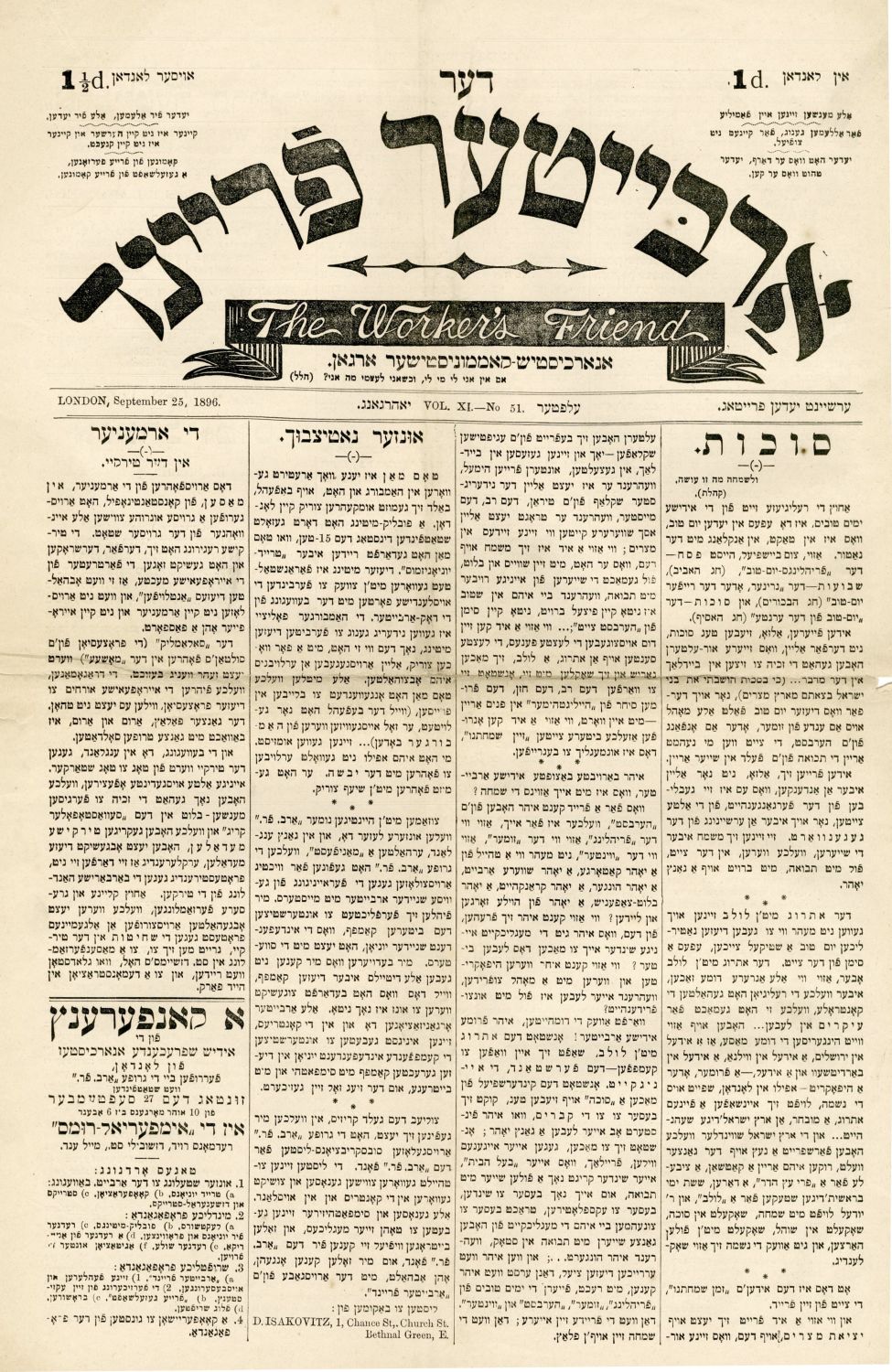
13 issues of Anarchist Weekly 'arbieter frind' - worker friend, published in London in 1885-1914. The phrase was the tool of the radical left. Rare.
Issues from the months:
* May June, July, August, September, October, December - 1896.
* December 1898.
The weekly newspaper 'Arbitrator Friendly Anarchist Communist Organ' was founded in 1885 by Maurice Winchevsky. After Saul Janowski immigrated to the United States in 1894, Wolf Voss became editor of the paper. Among the writers were Abraham Frumkin, Shalom Schwarzbard, and David Edelstadt. In 1903, the paper began to be published under the leadership of the Arbeter Freind group and edited by Rudolf Rucker as an expression of the Federation of Yiddish-speaking anarchist groups in Britain and Paris. When the First World War broke out, the British government banned the paper. The anarchist London-speaking Yiddish community did not recover after the Russian war and revolution. Many of its members have joined the Zionist movement, the Labor movement or the Communist movements. At the end of the war, Roker was deported to the Netherlands.
13 sheets in total. General condition: Good
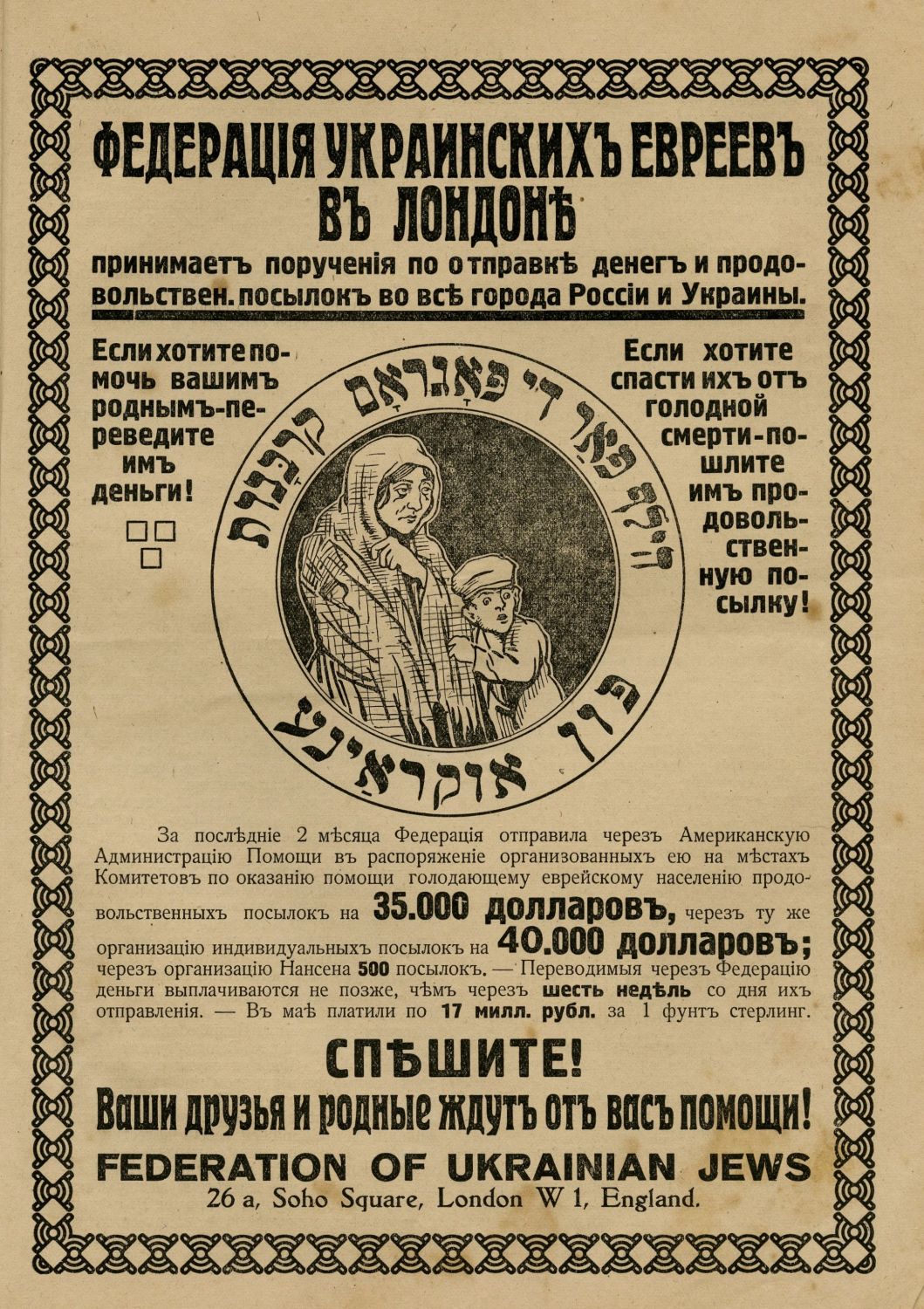
RASSWJET - magazine of the revisionist Zionist leadership, in Berlin and then in Paris. Russian and Hebrew. 31 sheets.
Year 1922 Issues: 1, 4, 7, 10, 16, 19.
Year 1923 Issues: 5, 8, 15,10, 21, 23, 25, 29-30, 33, 35-45, 49, 50.
1924 Issues 90-92.
1927: Issues 4, 6, 7.
The magazine "Razsweit" ("The Dawn") began in Russia as a Jewish journal in 1860 in its first incarnation, edited by a group of Jewish intellectuals, including Yehuda Leib Pinsker. The weekly closed after a short time and continued to operate in a number of periods and places until 1934. From 1904 to 1915, The paper was a major factor in Jewish communities. In 1922 his seat was relocated to Berlin.
From 1924 to 1934 he operated in Paris, then became the revisionist shofar and was called by Russian speakers all over the world. His most notable writers and outlines were Ze'ev Jabotinsky and Abraham Idelson. In December 1924, the weekly operated under the patronage of Jabotinsky, who published the paper almost alone for the first six months. In the headline of the old newspaper the revisionist slogan read: "The purpose of Zionism is: Israel as a single state on both sides of the Jordan." Jabotinsky’s articles, which discussed both current affairs and the coverage of struggles for national independence in Europe, placed him as one of the first political writers of Russian Jewry. In his articles and speeches, he continued to go directly against assimilation and against Russian revolutionaries and liberals who did not blame the authorities for their anti-Semitic steps, so as not to be "identified with the Jews." During this period, the newspaper became a major factor in the Jewish communities, and promoted and designed a Zionist movement for the national liberation of the Jews. The newspaper circulation increased from two thousand subscribers to over 30,000 subscribers, in some 2000 localities.
Moderate - good condition. Some of the sheets have tears and stains. Some with detached pages.

24 issues of 'Bat Kol' weekly edited by Yosef Zeliger Halevi, Lvov 1913. The weekly issue published every Saturday evening in Lvov (Lemberg).
sheets: 3-19, 21, 23, 25-27, 29-32. Adar - Elul 1913
The weekly was published between 1912 and 1919.
In 1912, Dr. Joseph Seliger Halevi [1872-1919] founded the "Bat Kol" newspaper, which began as a daily newspaper, in which he published political, social and literary articles, and a weekly supplement called "Yavne", which contained research articles and fine literature. That year nine issues were published in Krakow. The objections to his actions, which were on the part of both the religious The religious establishment, and the reformed establishment, made his work difficult. In order to reduce financial expenses and facilitate the circulation of the newspaper, he moved the system to the central city of Lviv, and published it as a weekly instead of a daily newspaper. Among the poets and writers who published their articles in the paper were: Menachem Mendel Braunstein, S. Cook, S.Z. Yabetz, Rabbi Moshe Lighter and others.
Stains in some sheets, tears to edges. Good condition.
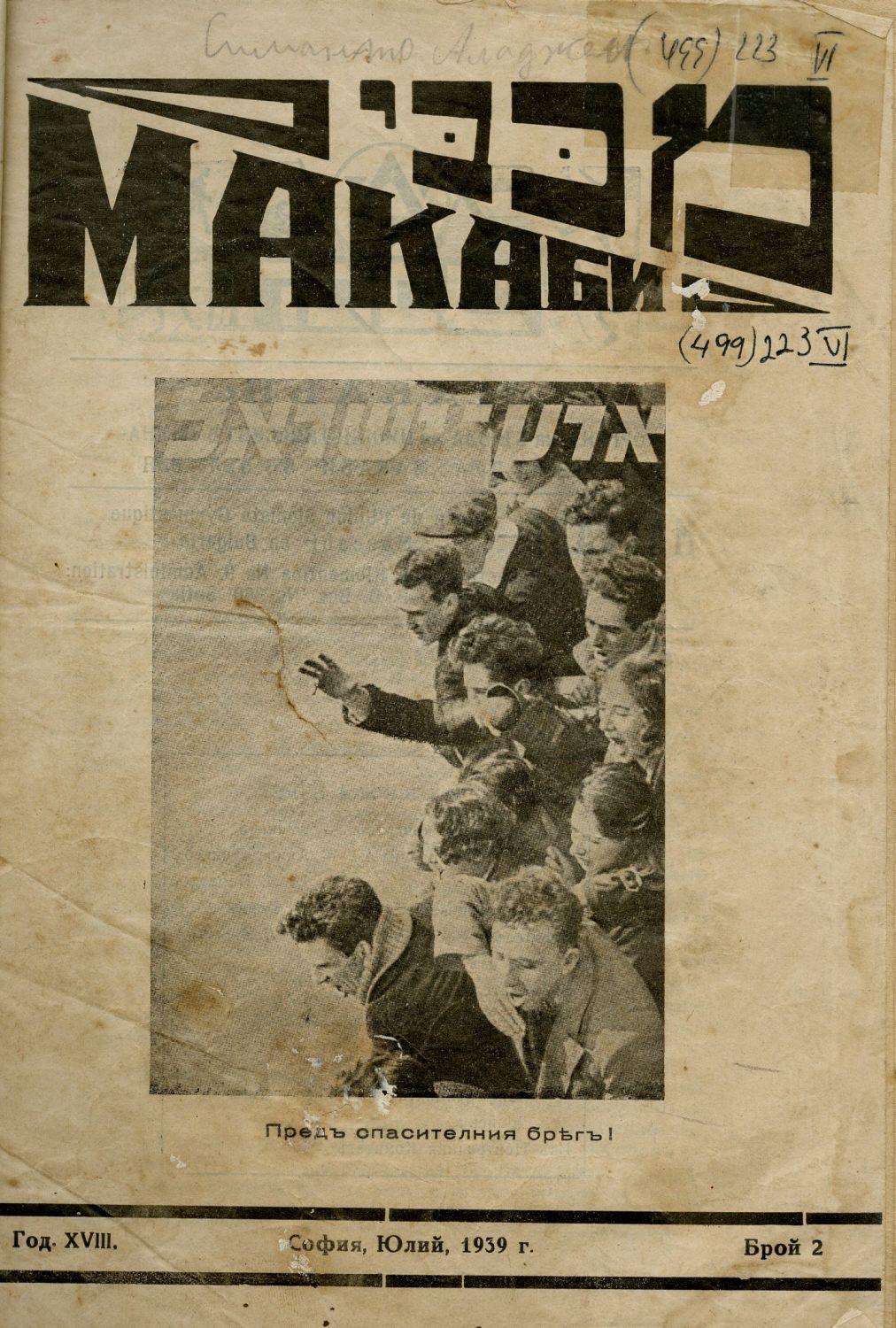
Two issues of the Maccabi movement in Russia. May 1938, 1939. Rare sheets in Russian issued on the eve of the terrible Holocaust. Photographs of the Maccabi convention at Haifa Stadium, as well as immigrants to Eretz Israel.
Come with cardboard in the back and protective plastic. Stains, good condition.
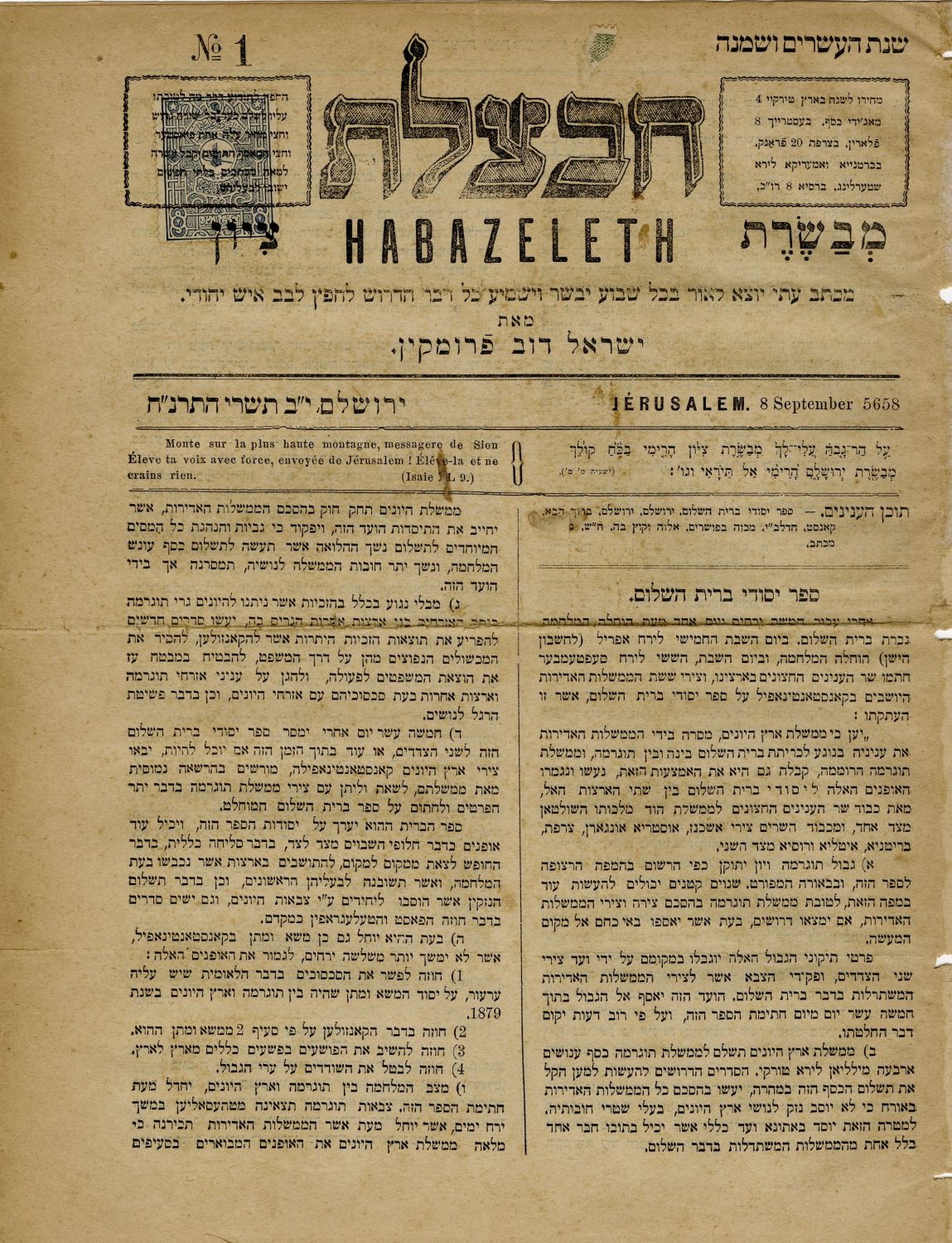
A collection of 45 issues of the journal 'Havatzelet' founded by Rabbi Yisrael BK. Years: 1898-1901.
Year: 1898 (Year 28). Sheets: 1-7, 9, 12-13 (Issue 13 Announces Sultan Abdel Eeal Hamid's 2nd Birthday), 16, 18-21 (Third of the Maharal Diskin's Death), 24, 26, 35 , 37 ("Long live the King" issue for depreciation of Jerusalem Sultan Muhammad Dashuyad Bay), 47.
Year: 1899 (29th Year). Sheets: 2, 7, 13, 16, 19, 20, 24, 28.
Year: 1900 (30th year). Sheets: 7, 34, 38.
Year: 1901 (31st year). Sheets: 2, 4, 7, 8, 14, 16, 19, 22, 26, 28-30, 33.
"Havatzelet: a letter time for Beth Israel" - one of the pioneers of Hebrew journals in Jerusalem. Started in 1863 by Israel BK, and from 1870 to 1911 edited by his son-in-law, Israel Dov Frumkin. Initially, it was published twice a month. In October 1871, it became a weekly.
The paper put Jerusalem and its affairs at the forefront, and was founded as a competitor to "Lebanon", which was the newspaper of the old settlement people, while the Havatzelet represented the followers of the Hasidim and to some extent the Sephardim in Jerusalem. In every issue of the newspaper, a section was devoted to the settlement of the country, with information on the development of the settlement. The paper had a clear tendency to instill a sense of security and prosperity and to attract settlers to Israel, Thus, a series of travel stories of Joshua Yellin were published (from issue 19 of Year 2), articles by Rabbi Yehuda Alkalay due to the commandment of the settlement of Eretz Yisrael and a sharp polemic against Aharon Yehuda Leib Horowitz Who exhorted Jews to emigrate to the United States and against discrimination in the "Haluka".
All the printed material was on Frumkin's mind and influence. Among the regular writers in the paper were Avraham Lunz, Shlomo Buber, Avraham Bar Gutlover and more. Some were not residents of the country, and sent articles from abroad. The newspaper was the first Hebrew newspaper in Israel to be published in a long period of time - more than forty years. It was named after a street in central Jerusalem near Zion Square, 'Havatzelet Street'.
The shipping stamp appears on all sheets. General condition: Good. Stains.
Created and Develop with 🤍By webe ©2024